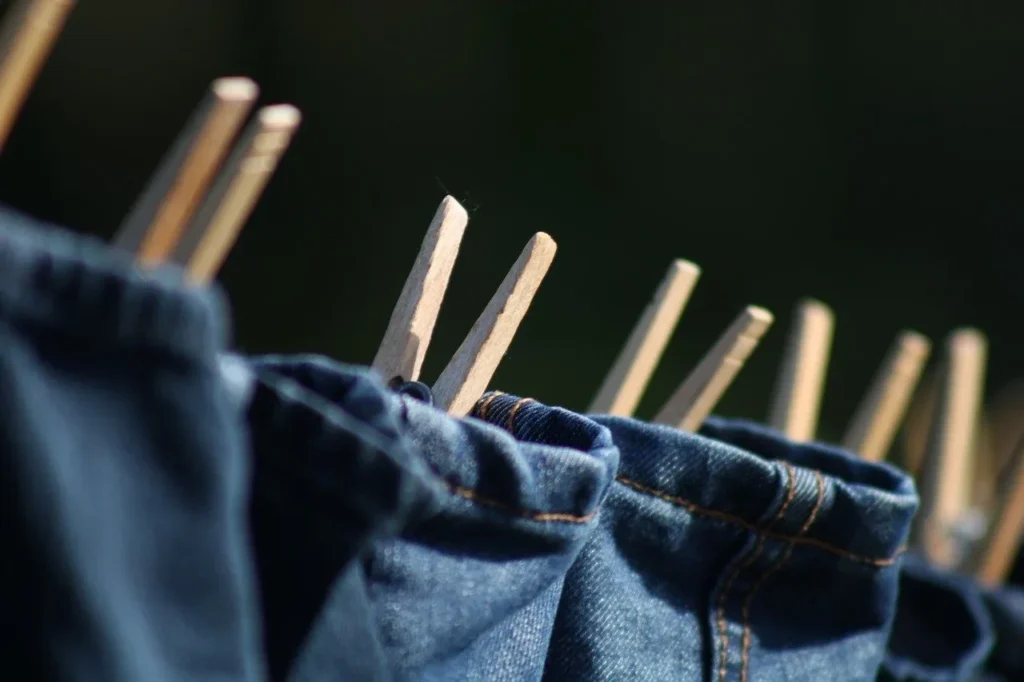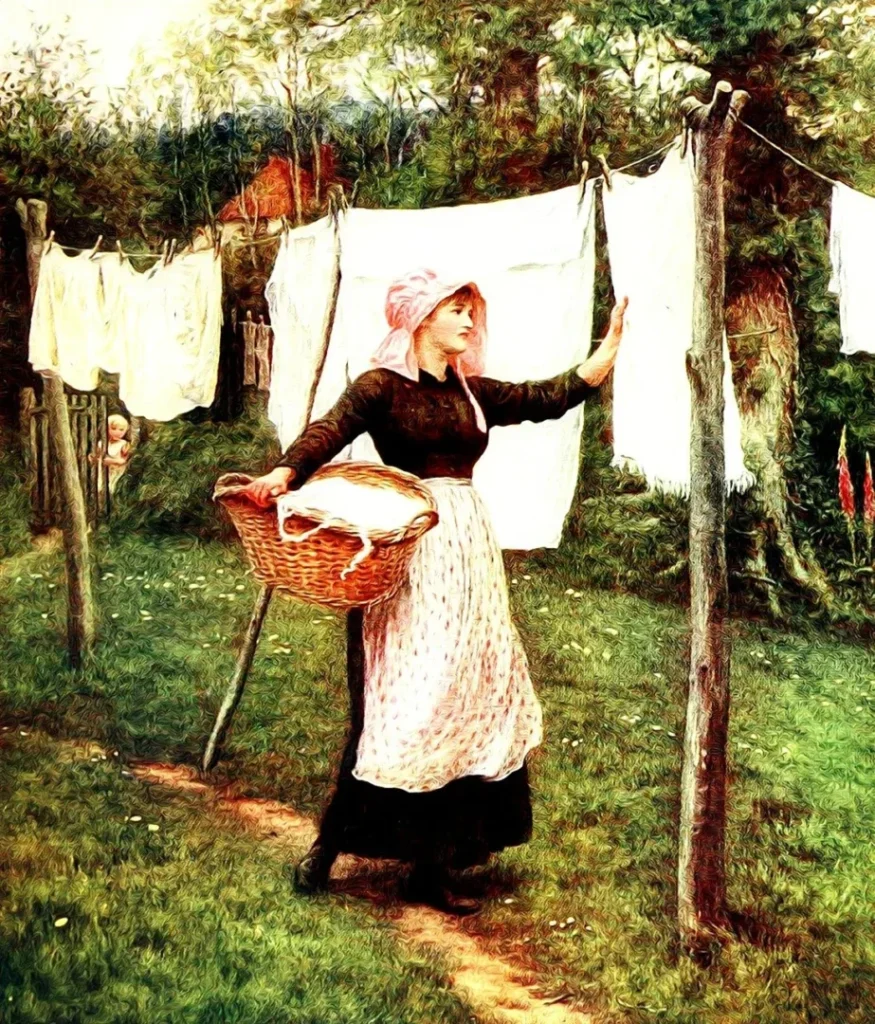So you’ve just washed your favorite pair of jeans and you’re now faced with the dreaded task of drying them without shrinking them. We’ve all been there, worrying about ending up with jeans that are two sizes too small. But fear not, because we’ve got you covered. In this article, we’ll explore some tried-and-true techniques to ensure that your jeans come out of the dryer perfectly fitted, without losing any of their original charm. Say goodbye to the fear of shrinking jeans and hello to a stress-free laundry routine!
Understanding Denim Fabric
Denim, a classic and durable fabric, has become a staple in many wardrobes. Whether it’s in the form of jeans, jackets, or skirts, denim is found everywhere. But have you ever wondered about the origin and characteristics of denim fabric?
Denim’s Origin and Characteristics
Denim fabric has a rich history that can be traced back to the 17th century. Its name is derived from the French phrase “serge de Nîmes,” which translates to “fabric from Nîmes.” Nîmes was a city in France renowned for its textile production, and this is where the fabric was first created.
Denim is predominantly made from cotton, which gives it its strength and durability. The fabric is woven using a twill weave, which means that the diagonal pattern created by the weaving technique is visible on the surface. This twill weave also contributes to the characteristic look and feel of denim.
One of the defining features of denim is its indigo dye. Traditionally, denim was dyed using indigo, which resulted in the iconic blue color we associate with the fabric. This dyeing process also gives denim its unique fading properties, as the indigo dye gradually wears off over time.
Why Denim Tends to Shrink
Now that we have a better understanding of denim fabric, let’s delve into the reasons why denim tends to shrink. Shrinkage is a common concern, especially when it comes to jeans, as nobody wants their favorite pair of denim to become too small after a few washes.
Reasons for Jean Shrinkage
Effects of Heat on Denim
Heat plays a significant role in causing denim to shrink. When exposed to high temperatures, the fibers in the fabric contract and tighten, resulting in a reduction in size. This process is further exacerbated by the use of hot water during washing.
Changes in Fibers During Washing and Drying
Another factor contributing to jean shrinkage is the changes that occur in the fabric’s fibers during the washing and drying process. The agitation and movement in the washing machine, combined with the heat from drying, can cause the cotton fibers to shrink and lose their original shape.
To prevent jean shrinkage, there are several steps you can take before, during, and after washing your denim.

Preventing Jean Shrinkage Before Washing
Proper Sorting of Laundry
Before tossing your jeans into the washing machine, it’s crucial to sort your laundry properly. Denim should be separated from delicate fabrics that require gentle washing cycles as the rigorous movement can agitate the fibers and contribute to shrinkage.
Using Cold Water Washes
When it comes to washing your jeans, opt for cold water instead of hot. Coldwater helps minimize shrinkage as it doesn’t cause the fibers to contract and tighten as much as hot water does.
Hand Washing Jeans
If you want to go the extra mile in preventing shrinkage, consider hand washing your jeans. Hand washing provides more control over the process, ensuring that you can avoid exposing your denim to excessive heat and agitation.
Avoiding Hot Dryer Temperatures
Heat Impact on Denim
As mentioned earlier, heat is a major culprit when it comes to jean shrinkage. Therefore, it’s essential to avoid subjecting your denim to high dryer temperatures, as this can cause the fabric to shrink significantly.
Guidelines for Machine Drying Denim
If you prefer using a dryer to dry your jeans, there are a few guidelines you can follow to minimize shrinkage. First, set the dryer to a low or medium heat setting. Secondly, make sure to remove the jeans from the dryer while they are still slightly damp to prevent over-drying and further shrinkage.
Alternatives to Traditional Drying Methods
If you want to be extra cautious and avoid using the dryer altogether, there are alternative drying methods you can try. One popular option is air drying, which not only helps prevent shrinkage but also preserves the quality and longevity of your jeans.

Air Drying Jeans
Steps for Proper Air Drying
When air drying your jeans, start by gently wringing out any excess water after washing. Then, lay your jeans flat on a clean, dry towel, making sure they are not bunched up or folded. Allow them to air dry naturally, flipping them occasionally to ensure even drying.
Avoiding Direct Sunlight While Drying
While air drying is an effective method for preventing jean shrinkage, it’s important to avoid drying your denim in direct sunlight. Sunlight can fade the color of your jeans and may cause the fabric to become stiff or brittle over time.
Reshaping Jeans Post Wash
Gentle Stretching Techniques
Sometimes, despite our best efforts, our jeans may still shrink slightly. If this happens, don’t fret – there are ways to reshape them. One technique is to gently stretch the waistband and legs of the jeans while they are damp. Be careful not to pull too hard, as this can lead to fabric damage.
Methods for Preserving Jean Shape
To preserve the shape of your jeans, consider folding them along the original creases when storing them. Additionally, avoid hanging your jeans for extended periods, as this can cause them to stretch out or lose their shape over time.
When to Reshape Your Jeans
If you notice that your jeans have significantly lost their shape or have become excessively tight, it might be time to reshape them. Regular assessment of your denim’s fit and shape will help you catch any changes early on and take appropriate measures to restore them.

The Role of Fabric Softeners and Dryer Sheets
Potential Dangers of Fabric Softeners
Fabric softeners are commonly used to make laundry feel soft and smell pleasant. However, when it comes to denim, fabric softeners can be problematic. The chemicals in fabric softeners can break down the fibers in denim, leading to weakened fabric and increased shrinkage.
Benefits of Using Natural Softeners
If you prefer softer denim, consider using natural alternatives to fabric softeners. Options such as white vinegar or baking soda can help soften the fabric without causing any harm to the jeans. Simply add a small amount of vinegar or baking soda to the rinse cycle or use them as a soak before washing.
How to Use Dryer Sheets Correctly
If you still prefer using dryer sheets, be sure to use them correctly to minimize shrinkage. Place a dryer sheet in the dryer with your jeans, and set the dryer to a low heat or air-only setting. Avoid using dryer sheets with excessive fragrance or chemicals, as these can potentially damage the fabric.
Dealing with Pre-Shrunk Jeans
Understanding the Pre-Shrunk Label
Some jeans come with a pre-shrunk label, indicating that the fabric has already been subjected to a shrinking process before it reaches the consumer. While pre-shrunk jeans are less likely to shrink significantly, they may still experience some minimal shrinkage over time with repeated washes.
Drying Pre-Shrunk Jeans without Further Shrinkage
To prevent any further shrinkage in pre-shrunk jeans, it’s best to follow the recommended care instructions. Use a gentle washing cycle with cold water and a low heat or air-only setting when drying. By avoiding high temperatures and excessive agitation, you can help preserve the size and fit of pre-shrunk jeans.
Importance of Jeans Care Label
Decoding Laundry Symbols
The care label found on your jeans is a valuable resource when it comes to understanding the appropriate care instructions for your denim. Take the time to familiarize yourself with the laundry symbols and instructions provided, as they will guide you in properly laundering and preserving your jeans.
Why Manufacturers’ Care Instructions are Crucial
Manufacturers’ care instructions are crucial because they are specific to the fabric and construction of your jeans. Following these instructions ensures that you are treating your denim in the best possible way, reducing the risk of shrinkage and other damage.
Preserving the Life of Your Jeans
Reducing Frequency of Washes
One effective way to preserve the life of your jeans and minimize shrinkage is by reducing the frequency of washes. Denim doesn’t necessarily need to be washed after every wear. Instead, consider spot cleaning or airing out your jeans between washes to maintain their freshness.
Proper Storing of Jeans
When it comes to storing your jeans, it’s important to take care of the fabric and avoid any unnecessary stress on the fibers. Fold your jeans along the original creases and place them in a drawer or shelf. Avoid hanging your jeans for extended periods, as this can cause them to stretch out or lose their shape.
Maintaining the Colour and Texture of Denim
Preserving the color and texture of your denim is essential for keeping your jeans looking their best. Wash your jeans inside out to minimize fading and preserve the indigo dye. Additionally, avoid ironing your jeans unless absolutely necessary, as the heat can cause the fabric to lose its texture and crispness.
In conclusion, understanding the unique characteristics of denim fabric and the factors that contribute to shrinkage can help you take better care of your jeans. By implementing preventive measures during the washing and drying process, utilizing alternative drying methods, and following manufacturers’ care instructions, you can maintain the size, shape, and quality of your denim for years to come. Remember, a little extra care can go a long way in preserving the life of your favorite pair of jeans.